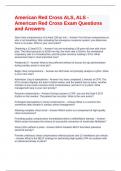Exam (elaborations)
American Red Cross ALS, ALS - American Red Cross Exam Questions and Answers
- Course
- Institution
Start chest compressions of at least 100 per min. - Answer-You find an unresponsive pt. who is not breathing. After activating the emergency response system, you determine there is no pulse. What is your next action? Obtaining a 12 lead ECG. - Answer-You are evaluating a 58-year-old man with che...
[Show more]



